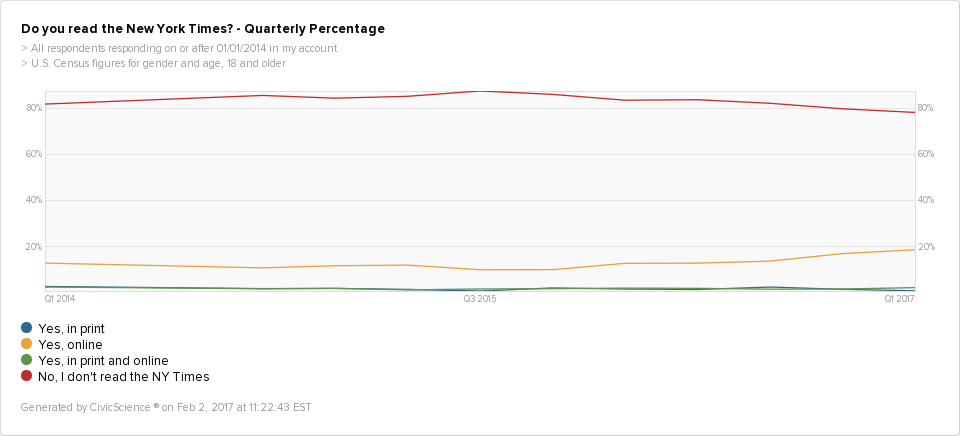Today, the New York Times reported its highest quarterly digital subscriber growth since 2011. Despite what could only be characterized as a Twitter assault on the Gray Lady by President Trump, he may inadvertently be driving its growth.
According to CivicScience’s 3-year tracking data, increases in NY Times digital readership do not appear to just be a recent phenomenon. See for yourself:
 While overall readership (print and digital) among U.S. adults appeared to have bottomed out in calendar Q3 of 2015, we started to see subtle growth in digital readership shortly thereafter. From a low point of 10% of online U.S adults in mid-2015, the numbers climbed to 13% by the end of Q1 2016 and 14% by the end of Q3. That’s when we started to see the steepest climb, with digital readership jumping to 17% by the end of Q4 and now over 19%, just one month into 2017.
While overall readership (print and digital) among U.S. adults appeared to have bottomed out in calendar Q3 of 2015, we started to see subtle growth in digital readership shortly thereafter. From a low point of 10% of online U.S adults in mid-2015, the numbers climbed to 13% by the end of Q1 2016 and 14% by the end of Q3. That’s when we started to see the steepest climb, with digital readership jumping to 17% by the end of Q4 and now over 19%, just one month into 2017.
It’s important to note that these numbers reflect “readers” and not “subscribers,” which are the numbers the NY Times reported today. Still, our numbers show a consistent pattern of growth that appears to parallel the NY Times paid subscriber reports.
We can also see where this growth is coming from, demographically speaking. In the 8 months leading up to August of 2016, 48% of online NY Times readers were women. In the six months since August, the percentage of female digital readers jumped to 52%. Age numbers didn’t move very much.
Digital readers who reported having a graduate or professional degree increased from 24% of respondents 6 months ago to 29% now. Growth was highest among middle-income readers, particularly those making between $50,000 to $100,000 per household. The biggest jump, statistically, came from people without children or grandchildren, growing from 45% of digital readers to 56% of readers in the past 6 months.
But here’s the surprising one: the growth of digital readership seems to have crossed party lines. Prior to August, 6% of our Republican respondents said they read the NY Times online. That number grew to 10% in the past 6 months. Numbers also grew from 18% to 23% among Democrats and from 14% to 18% among Independents.
It will be interesting to see if these numbers continue to climb or level off in the coming months. But, for now, there’s little doubt that the Donald Trump has been great for the New York Times.
Interested in other journalism insights? Check out our recent post, “What’s the Price for Good Journalism?“








